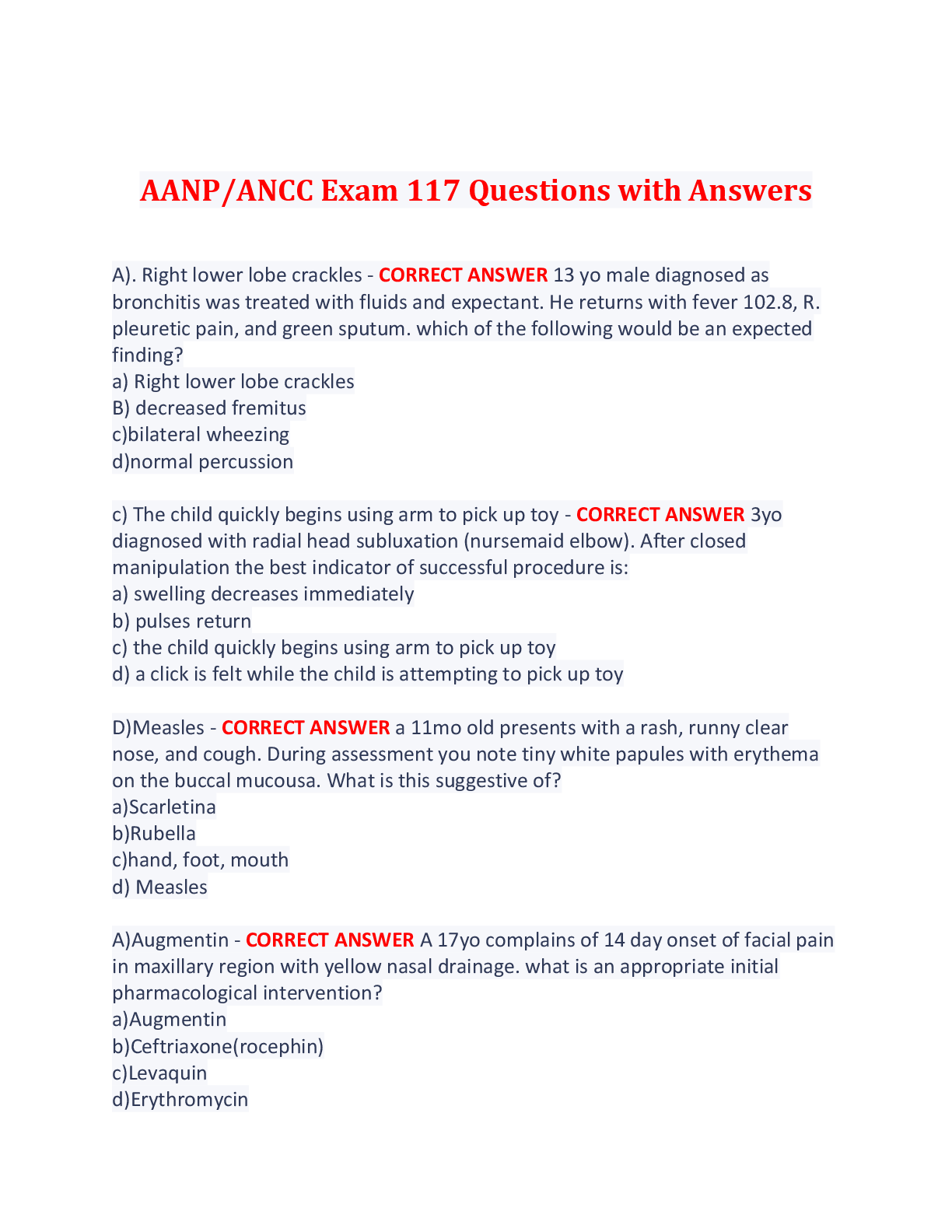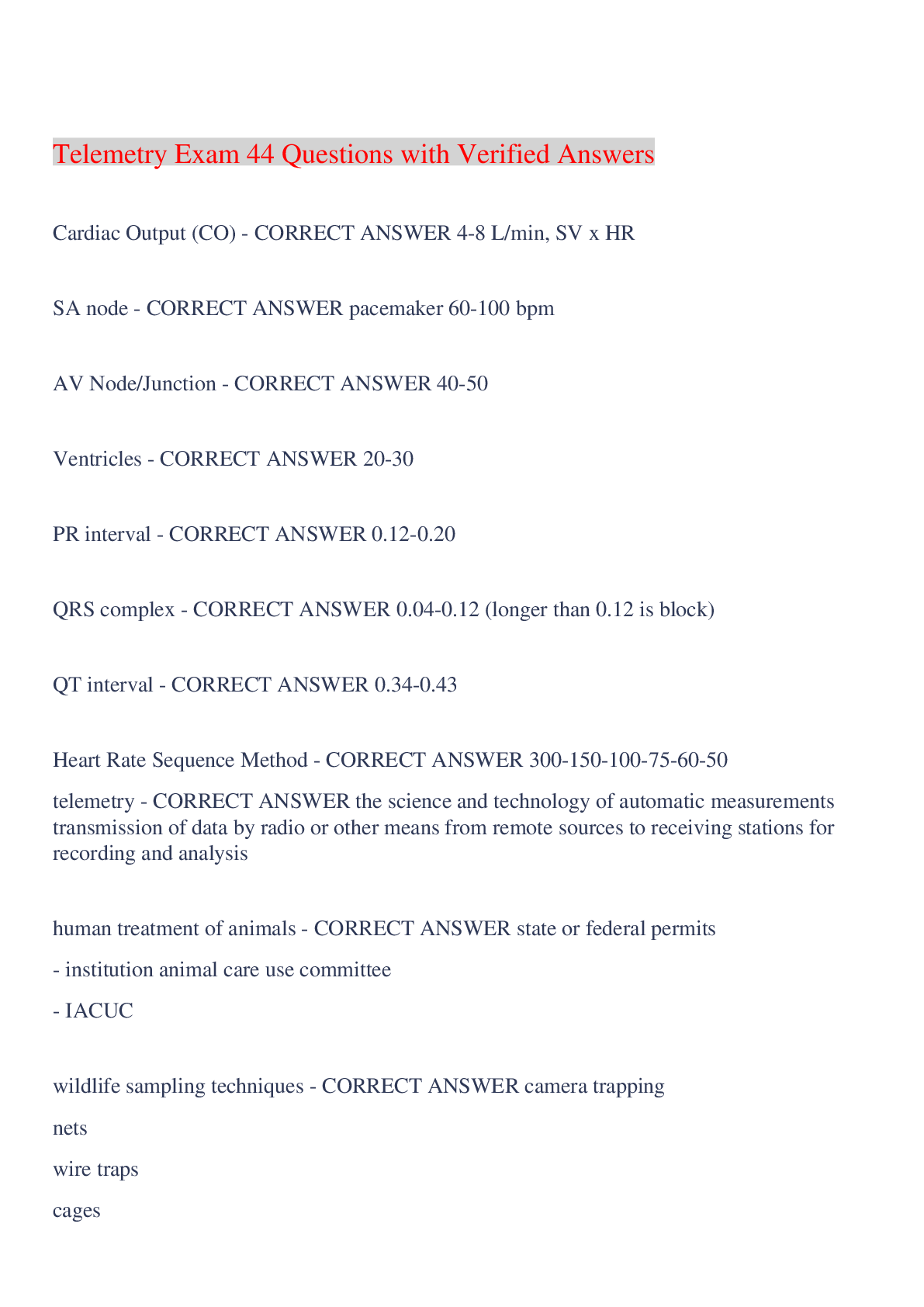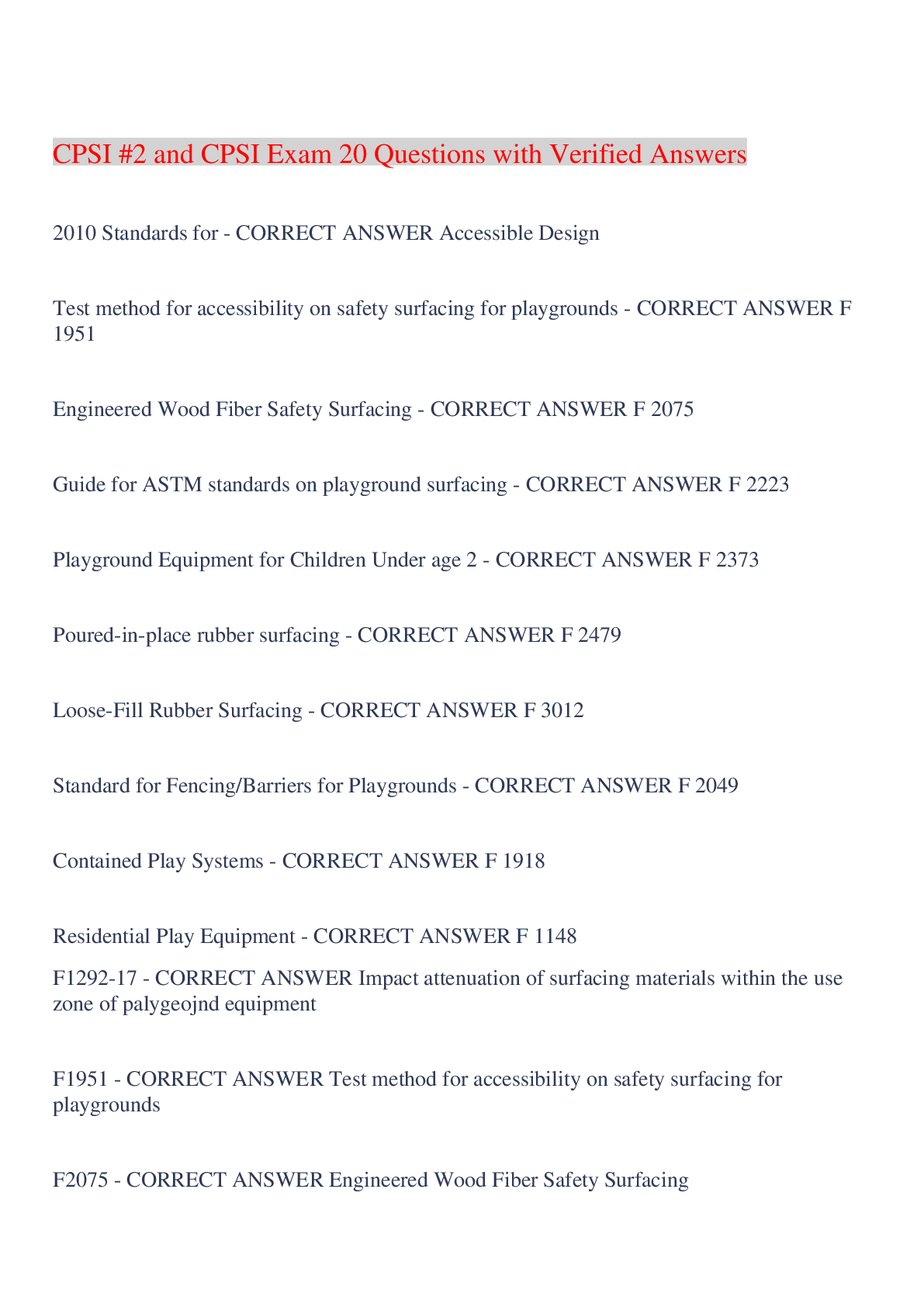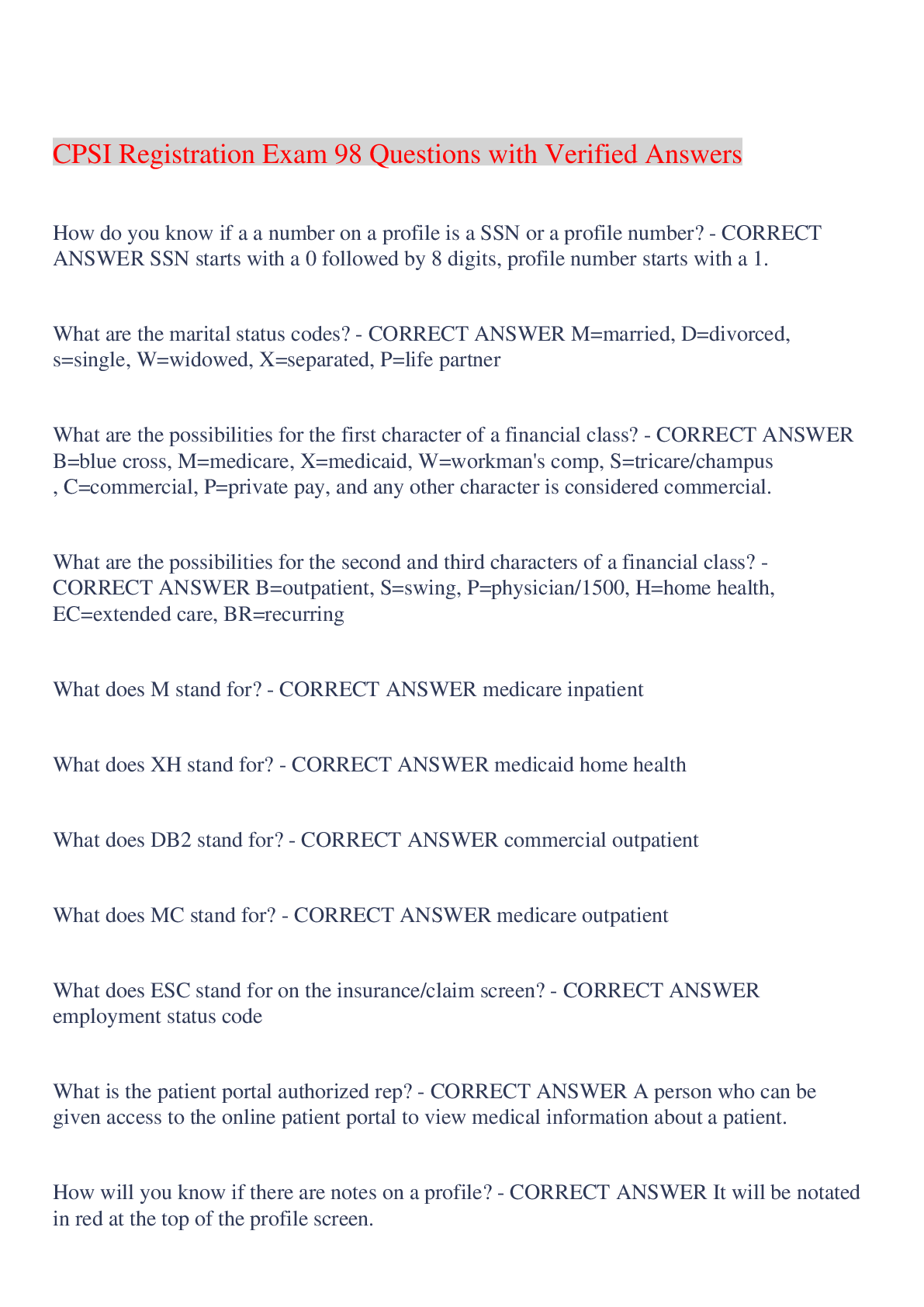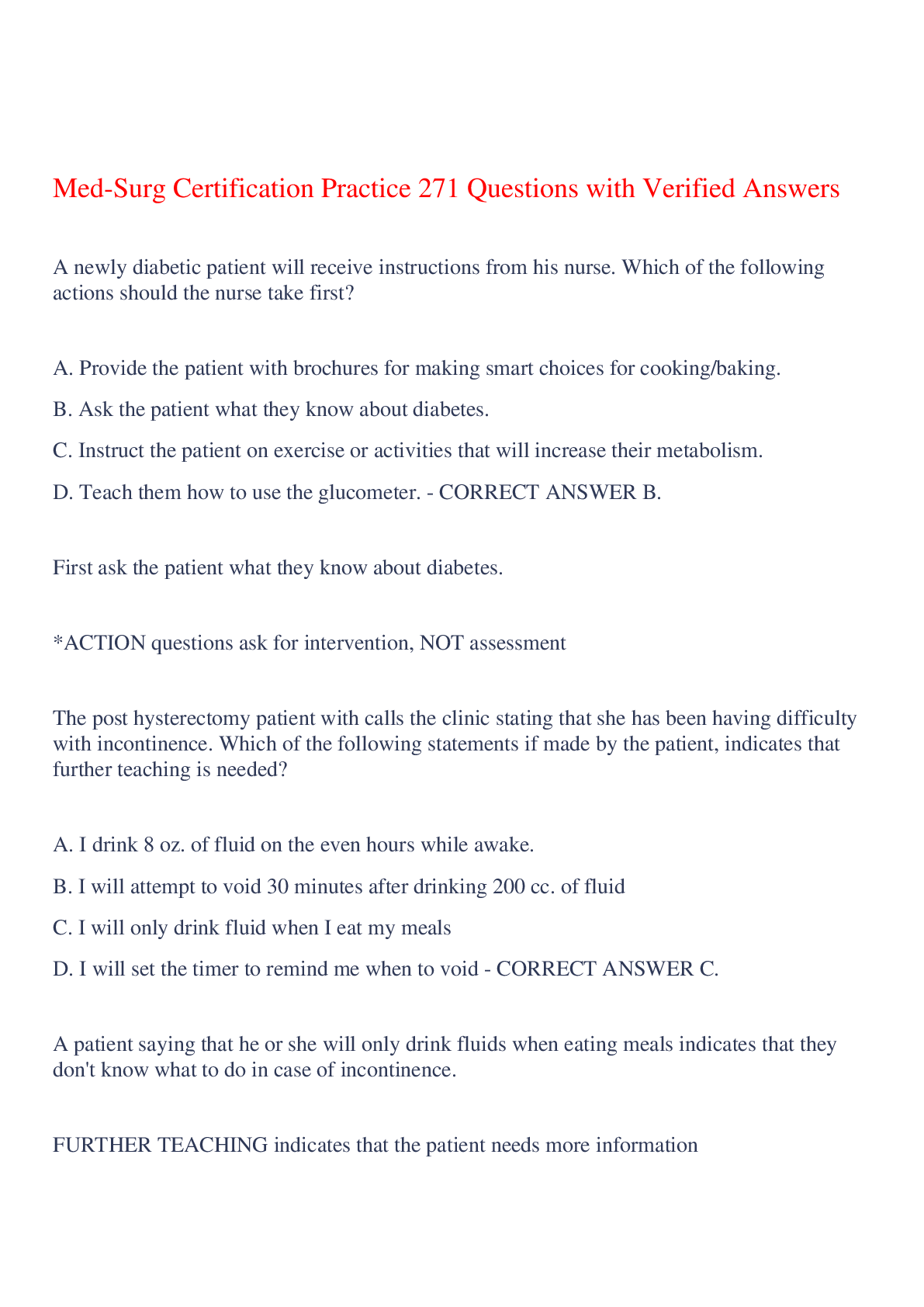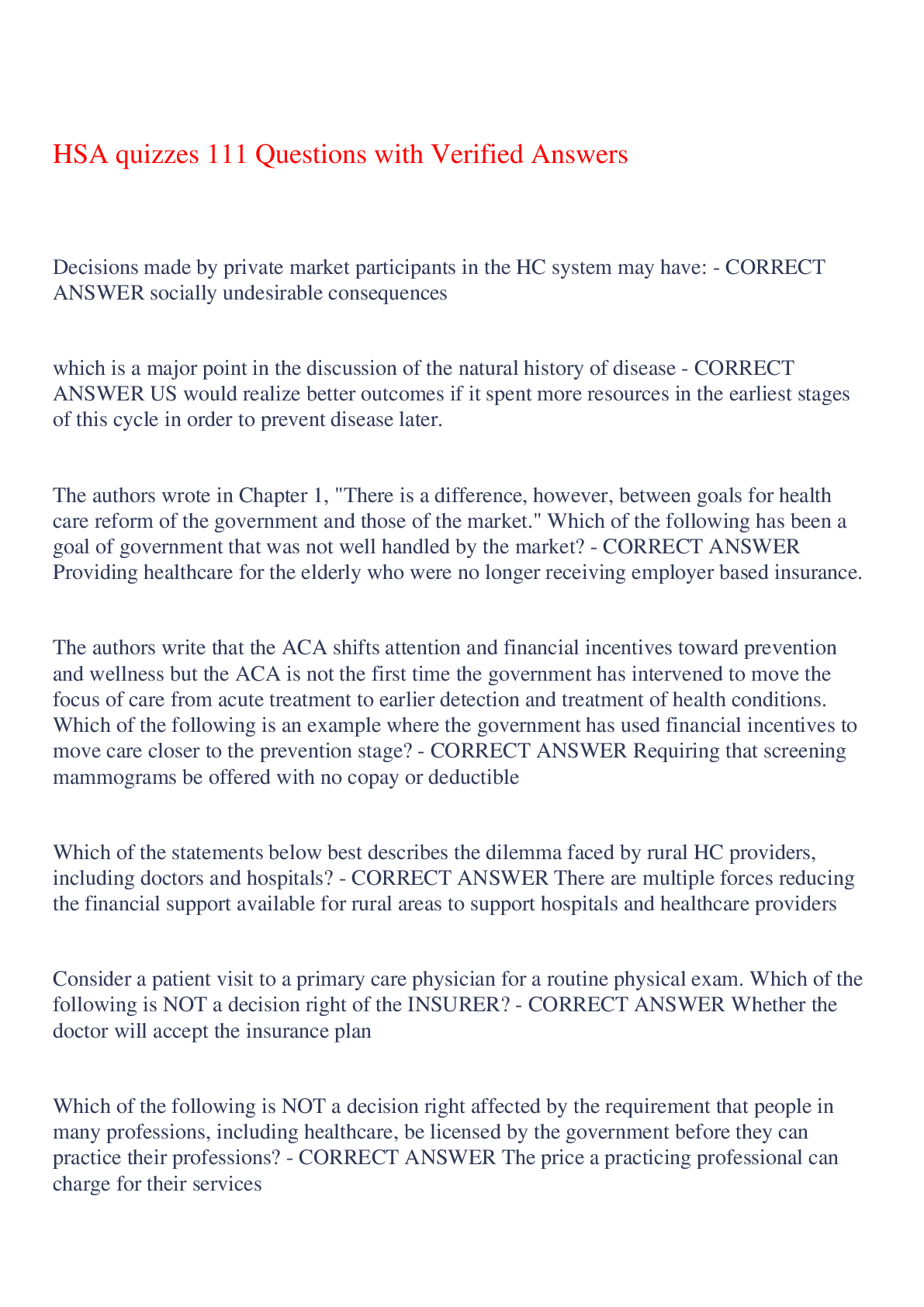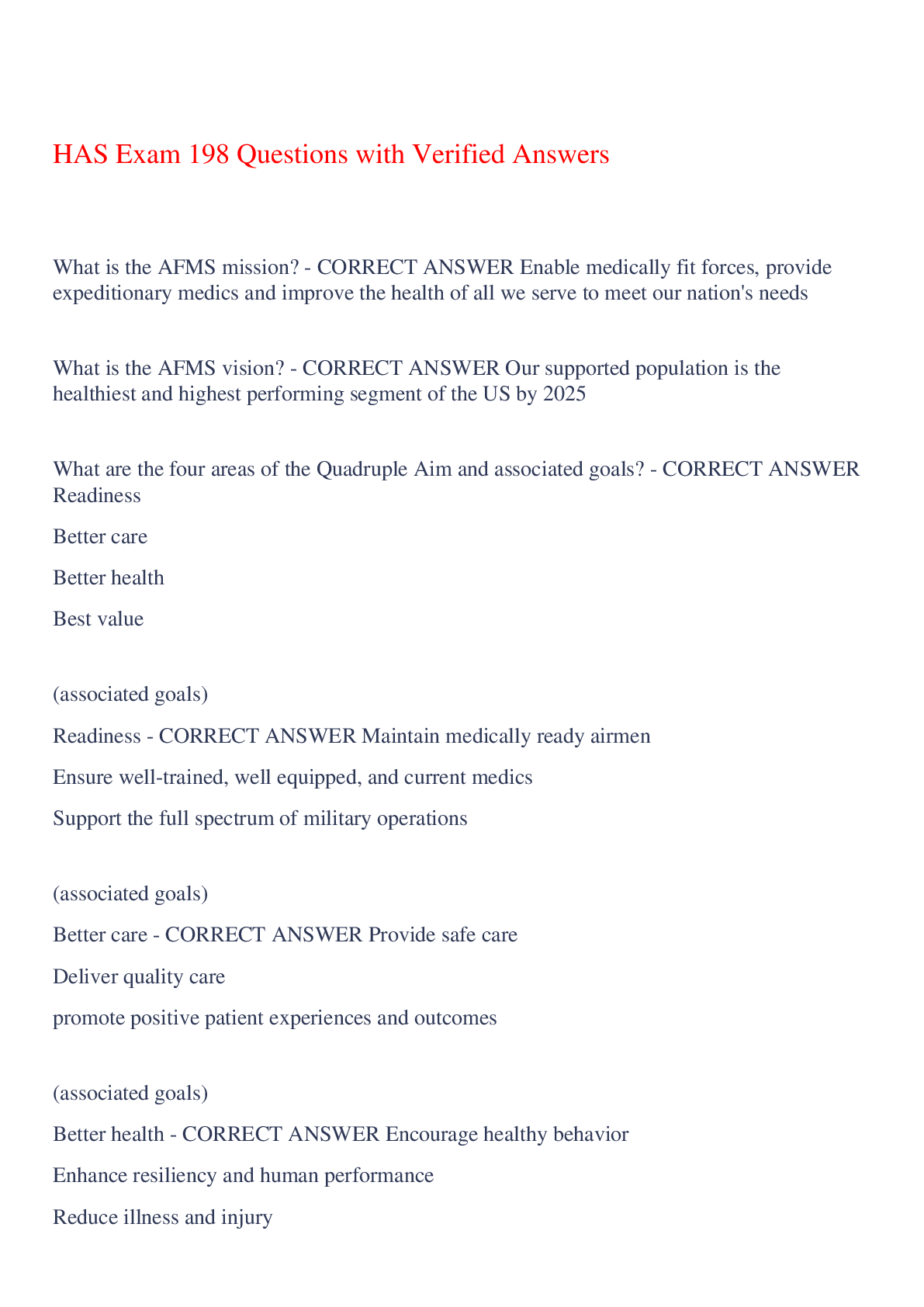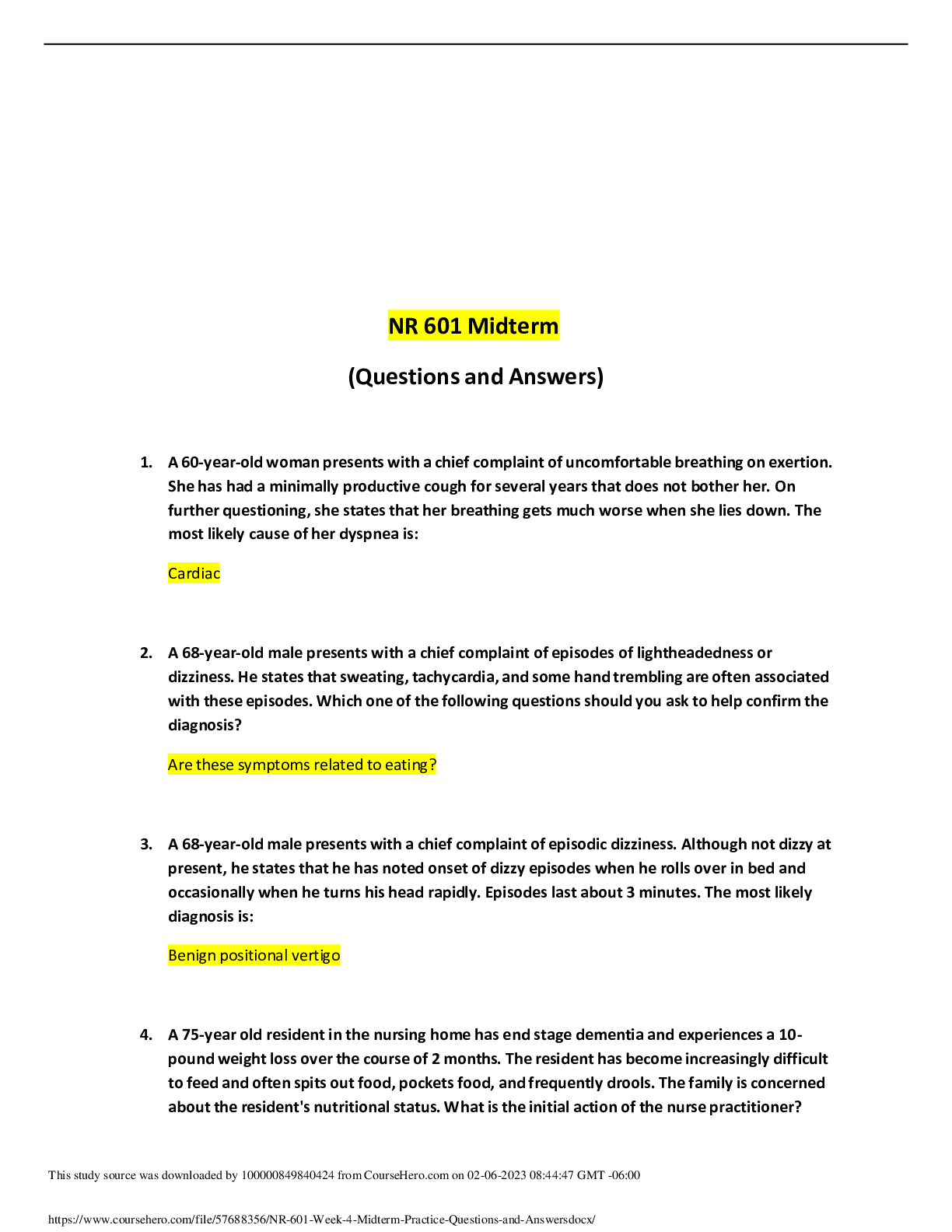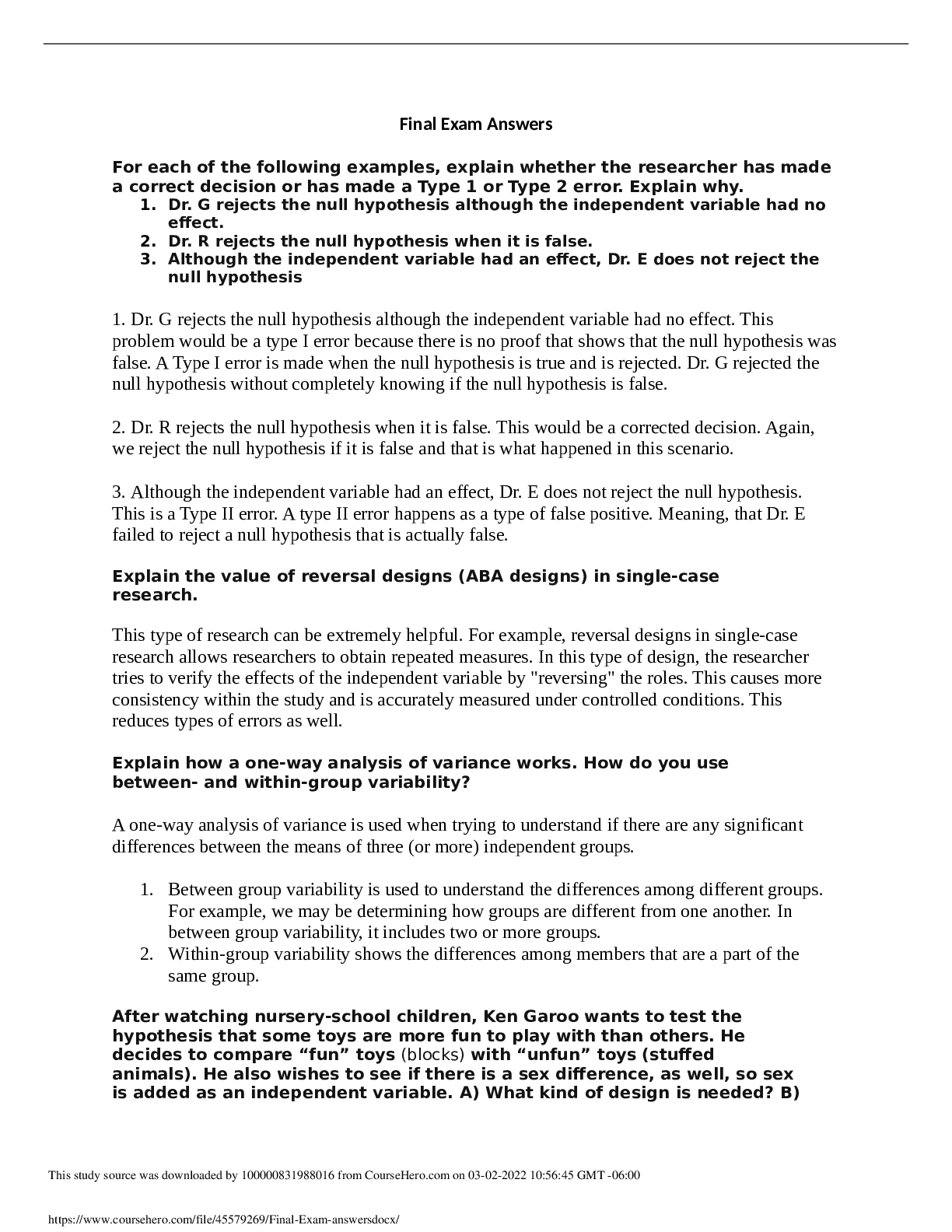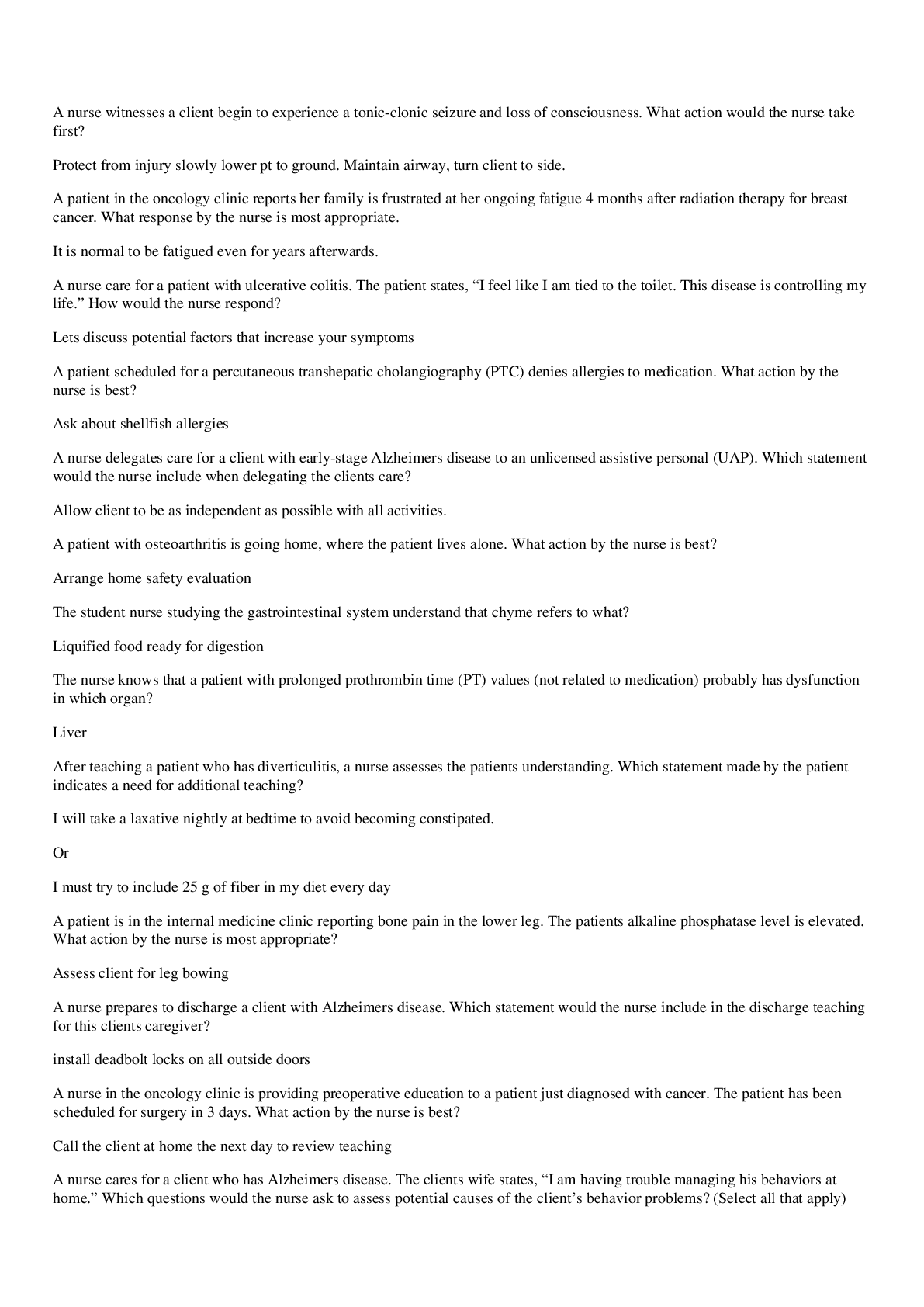English Language > EXAM > ALTA National Registration Exam 200 Questions and Answers,100% CORRECT (All)
ALTA National Registration Exam 200 Questions and Answers,100% CORRECT
Document Content and Description Below
ALTA National Registration Exam 200 Questions and Answers example of Greek words of origin - Correct Answersrhythm, chorus, thermometer, psychology, rhododendron, sympathy orthography - Correct ... Answersletter pattern in written words; spelling system NICHD - Correct AnswersNational Institute of Child Health and Human Development encoding - Correct Answersspelling/writing decoding - Correct Answersreading Semantics - Correct Answerscontent of language Analytic - Correct Answerswhole to part; reading Synthetic - Correct Answerspart to whole; spelling homophones - Correct Answerswords that sound the same but are spelled differently synonyms - Correct Answerswords that have the same meaning antonyms - Correct Answerswords with opposite meaning Homophones, Synonyms and Antonyms are all examples of ? - Correct AnswersSemantics What prefixes mean the same thing? - Correct Answerscontra-, anti- Syllable division is an example of what type of learning? - Correct AnswersBOTH Analytic and Synthetic A Teacher is using the overhead to teach, make diagrams and have students come up and fill in some of the answers. This is an example of? - Correct AnswersDiscovery Learning A child can read words easily in a list, but reads word by word in text. What form of remediation is needed? - Correct AnswersPhrasing When was Chall's research done? - Correct Answers1983 permit/permit - Correct Answersthe Accent changes the part of speech and meaning To diagnose dyslexia you would need to perform ? - Correct Answersa series of formal and informal tests A student having difficulty with semantics would struggle with? - Correct Answersmetaphors, similies and idioms "lexia" comes from? - Correct AnswersGreek What determines the amount to charge for tutoring? - Correct Answerssocioeconomics Morpheme - Correct Answerssmallest unit of meaning Phoneme - Correct Answerssmallest unit of sound in a syllable What word is NOT r-controlled? - Correct Answersberry What word doesn't have a use for the silent e? - Correct Answersawe Science and Mathematic words come from? - Correct AnswersGreek 504 is an extension of? - Correct AnswersThe Rehabilitation Act of 1973 What does ASAP stand for? - Correct AnswersAccent, number of Syllables, Adjacent letters, Position in the word dyslexia is a disorder that is________-based - Correct Answerslanguage Developmental Dyslexia is? - Correct Answersa glitch in the brain during fetal development that one is born with IDEA and 504 both mandate a ________ & _________ _________ Education - Correct AnswersF.A.P.E. (Free and Appropriate Public Education) Pragmatics is ? - Correct Answersthe practical application of language; conversation Soft C rule - Correct Answersc sounds like s before e, i and y Most recent pioneer in Phonemic Awareness? Wrote "Spelling: Development, Disability, and Instruction" - Correct AnswersLouisa C. Moats The accent usually falls on what syllable in the English language? - Correct Answersfirst What type of memory does Rapid Naming require? - Correct Answerslong-term memory What type of memory does Phonological Memory require? - Correct Answersshort-term memory Auditory Discovery - Correct Answerswhen the teacher leads students to new information, having them echo words to listen for the same new sound How should a teacher transition from one activity to another? - Correct Answerssignal Active Learning - Correct Answersstudents learn by connecting prior knowledge Chall's Stage 0 - Correct AnswersPre-Reading (0-6 yrs) Chall's Stage 1 - Correct AnswersDecoding (6-7 yrs) Chall's Stage 2 - Correct AnswersConfirmation (7-9 yrs/K-2) Chall's Stage 3 - Correct AnswersReading to Learn (9-14 yrs/3-8 gr.) Chall's Stage 4 - Correct AnswersMultiple Viewpoints (14-18 yrs/9-12 gr.) Chall's Stage 5 - Correct AnswersConstruction (18-Adult/University and beyond) Double Deficit - Correct Answersdeficit in Phonological Awareness and Rapid Naming Name 2 tests for Phonological Awareness - Correct AnswersTest of Phonological Awareness (TOPA-2), Phonological Awareness Test (PAT-2), Comprehensive Test of Phonological Processing (CTOPP)--- The CTOPP sections are: Phonological awareness, Phonological memory, and rapid naming Expressive Language includes - Correct AnswersForm, Use, Content Speaking is a receptive language skill.... True or False? - Correct AnswersFalse IDEA's "specific learning disability" refers to who? - Correct AnswersALL A parent wants a quick fix for her child. Your response should be? - Correct AnswersEvery child progresses at their own rate Explicit and Systematic Spelling Instruction includes? (phonological and orthographic? syntax/semantics? literal/figurative language? all of the above? - Correct AnswersPhonological and Orthographic A weakness in phonological processing causes all of the following EXCEPT? -weak decoding? -weak reading rate? -weak spatial orientation? -weak reading comprehension? - Correct Answersweak spatial orientation Which is NOT the same as phonological memory? -auditory short term? -orthographic memory? -verbal memory? -auditory working memory? - Correct Answersverbal memory Language processing difficulties are frequently misidentified as? - Correct AnswersADHD Which method is NOT effective for modeling speech sounds? - Correct Answerssinging ABC What syllable do you find the schwa vowel in? - Correct Answersunaccented syllable Taking students from the known to unknown (ex: short vowels to long) is an example of? - Correct AnswersDiscovery Method Which test does NOT test for Phonological Awareness - Correct Answersthe PPVT Where do you place a comma in a sentence with quotations? - Correct Answersbefore the closed quotation mark Where do you place a comma in this sentence: I didn't think it would take this long however - Correct Answersbefore the word "however" What are the four diphthongs? - Correct Answersou, oi, oy, ow Echolalia - Correct Answersthe repeating back of words or phrases in babies What is used to rate ADD - Correct AnswersConnors Dyscalculia - Correct Answersmath related disorder Strephosymbolia - Correct Answerstwisted symbols...coined by Orton A test that is performance-based in relation to a group; standardized - Correct AnswersNorm-referenced A test based on knowledge attained by the individual - Correct AnswersCriterion-referenced test A test based on material taught in the classroom - Correct AnswersCurriculum-referenced test Who is known for the latest research in coding? - Correct AnswersReid Lyon Research that collects data through various kinds of observations - Correct AnswersQualitative Research in which the results are based on a large sample that is representative of the population - Correct AnswersQuantitative Research in which the subjects are randomly assigned - Correct AnswersExperimental Research conducted without randomized assignment of subjects to experimental and control groups - Correct AnswersQuasi-Experimental A specific sensory pathway - Correct Answersmodality Pertaining to the simultaneous use of multiple senses - Correct AnswersMultisensory Area of the brain for Language Comprehension - Correct AnswersLeft Temporal Cortex Area of the brain for Speech Production - Correct AnswersLeft Frontal Cortex Area of the brain for Visual-Verbal Association - Correct AnswersAngular Gyrus Area of the brain for Visual Processing - Correct AnswersOccipital Cortex A specific language-based disorder characterized by difficulty with single-word reading - Correct AnswersDyslexia Speech problems caused by sensorimotor disruption - Correct AnswersDyspraxia Speech problems caused by musculature weaknesses - Correct AnswersDysarthria The melody of speech--stress, pitch, loudness, etc. - Correct AnswersSuprasegmentals Use of Language - Correct AnswersPragmatics Domains of Language - Correct AnswersPhonology, Morphology, Syntax gn, kn, wr; vowel pairs; common, everyday words; ch, sh, th, compound words; affixing of base words are all characteristics of which Layer of Language? - Correct AnswersAnglo-Saxon Layer roots ending in ct, pt; chameleon prefixes; c/s/t pronounced sh; affixing of roots; schwa vowel sound are all characteristics of which Layer of Language? - Correct AnswersLatin Layer initial consonant clusters rh, pt, pn, ps; medial y; combining forms; ph pronounced f are all characteristics of which Layer of Language? - Correct AnswersGreek Layer A consonant sound that consists of a slowly released stop followed by a fricative - Correct AnswersAffricate: /ch/, /j/ A sound produced by forcing air through the nose - Correct AnswersNasal: /n/, /m/ A sound that is produced by forcing air through a narrow opening between the teeth and lips to make a hissing sound - Correct AnswersFricative: /f/, /z/ A sound produced when the lips/tongue are passing from the position for one sound to that of another - Correct AnswersLiquid: /l/, /r/ A sound in which the outgoing air flow is completely stopped - Correct AnswersStop: /t/, /k/ Flowing and vowellike - Correct AnswersGlide: /w/, /y/ Phonological Awareness - Correct Answerssound structure of the language (skills progress from rhyming to syllable counting to detecting and manipulating phonemes) "How many sounds are in cheek?" is an example of: Isolation/Identification; Blending; Segmentation; Deletion/Addition? - Correct AnswersSegmentation "What is the first sound in lamp?" is an example of: Isolation/Identification; Blending; Segmentation; Deletion/Addition? - Correct AnswersIsolation/Identification "What word is /m/.../a/.../t/?" is an example of: Isolation/Identification; Blending; Segmentation; Deletion/Addition? - Correct AnswersBlending "Change the /l/ in lip to /s/" is an example of: Isolation/Identification; Blending; Segmentation; Deletion/Addition? - Correct AnswersDeletion/Addition Instruction that connects sounds and letters - Correct AnswersPhonics Rules that determine how sounds are used in spoken language - Correct AnswersPhonology Study of the characteristics of speech sounds - Correct AnswersPhonetics The understanding that spoken sounds are represented in print by letters - Correct AnswersAlphabetic Principle Awareness of the overall sound structure of words - Correct AnswersPhonological Awareness A variation of a speech sound - Correct AnswersAllphone Awareness of speech sounds or phonemes in spoken words - Correct AnswersPhonemic Awareness RAN - Correct AnswersRapid automatized naming A class of speech sounds with air flow that is constricted or obstructed - Correct AnswersConsonant A method of leading students to new learning through questioning - Correct AnswersGuided Discovery A letter or letter cluster that represents a single speech sound - Correct AnswersGrapheme A class of open speech sounds produced by the passage of air through an open vocal tract - Correct AnswersVowel When is c pronounced /k/? - Correct Answersbefore a, o, u or any consonant When is c pronounced /s/? - Correct Answersbefore e, i, y When is g pronounced /g/? - Correct Answersbefore a, o, u or any consonant When is g pronounced /j/? - Correct Answersbefore e, i, y When is n pronounced /n/? - Correct Answersin initial, medial or final position When is n pronounced /ng? - Correct Answersbefore any letter pronouced /k/, /g/ When is y pronounced with long-i sound? - Correct Answersfinal position in accented syllable (fly, supply) When is y pronounced with long-e sound? - Correct Answersfinal position in unaccented syllable (happy, penny) What are the 4 major patterns in English that indicate where a word will be divided into syllables? - Correct AnswersVCCV, VCV, VCCCV, VV What is the order of choices for syllable patterns for which syllable will be accented? - Correct Answers1. accent on first syllable 2. accent on second syllable 3. different division and accent on first syllable "struct" is an example of what type of morpheme? - Correct Answersbound morpheme "port" is an example of what type of morpheme? - Correct Answersfree morpheme -ed is an example of what type ending? - Correct Answersinflectional ending -ful is an example of what? - Correct Answersconsonant suffix /t/ and /d/ are examples of what? - Correct Answerscognates the "m" in met is an example of ? (not consonant) - Correct Answersan onset the "et" in met is an example of? - Correct Answersa rime A unit of speech - Correct AnswersSyllable Direct, purposeful instruction - Correct AnswersExplicit Instruction The overlapping of adjacent sounds when spoken - Correct AnswersCoarticulation Reading with rapidity and automaticity - Correct AnswersFluency The rhythmic flow of oral reading - Correct AnswersProsody FLOSS Rule - Correct AnswersDouble the final consonant if a one-syllable word ends in /f/, /l/ or /s/ RABBIT Rule - Correct AnswersDouble the medial consonant if one medial consonant sound after a short vowel in a 2-syllable word Doubling Rule - Correct AnswersIf Base word ends in 1 vowel, 1 consonant, and 1 accent, the final consonant is doubled before adding a vowel suffix (ex: omitted) Dropping Rule - Correct AnswersIf Base word ends in Final e, drop it before adding vowel suffix Changing Rule - Correct AnswersIf Base word ends in 1 consonant before final y, change y to i before adding a suffix DIBELS - Correct AnswersDynamic Indicators of Basic Early Literacy Skills PALS - Correct AnswersPhonological Awareness Literacy Screening Brief assessment that identifies students who may need additional or alternate forms of instruction - Correct AnswersScreening Periodic Assessment that measures progress in response to specific instruction - Correct AnswersProgress Monitoring Assessment that provides a detailed analysis of a student's strengths and weaknesses - Correct AnswersDiagnostic Measure Data that provide information about knowledge to be applied to short-term goals - Correct AnswersFormative Data Core components are goal setting, planning, organization of behaviors over time, flexibility, attention and memory systems, and self-regulation - Correct AnswersExecutive Function Federal legislation that requires special education and related services for qualified students with disabilities - Correct AnswersIDEA Federal law that protects the rights of people with disabilities - Correct AnswersADA Dividend - Correct AnswersA total amount that is to be divided by another number Divisor - Correct AnswersThe number that a total number is divided by coined the phrase "word blindness" 1877 - Correct AnswersAdolf Kussmaul coined the term "dyslexia" to describe word blindness 1887 - Correct AnswersRudolph Berlin Ophthalmologist at the Glasgow Eye Infirmiry; gave detailed description of acquired "word blindness" from a stroke victim; encouraged schools to screen for children with word blindness and provide them appropriate teaching techniques. 1895/1904 - Correct AnswersDr. James Hinshelwood First description of congenital word blindness 1896 - Correct AnswersDr. Pringle Morgan developed VAKT; 1920s - Correct AnswersGrace Fernald coined the term "strephosymbolia"/twisted symbols; cerebral dominance theory; adopted VAKT from Fernald; 1925 - Correct AnswersDr. Samuel T. Orton Psychologist and educator in NY; worked with Orton; Developed non-traditional approach to teaching written language skills; Trained 50 teachers w/Sally Childs. 1930-1960 - Correct AnswersAnna Gillingham Worked with Sally Childs; Wrote Alphabetic Phonics Curriculum at Scottish Rite Hospital in Dallas, 1960 - Correct AnswersAylette Cox Kinesthetic activities to establish Right to Left and Visual-Auditory Association with grapheme/phoneme 1960 - Correct AnswersBessie Stilman Connecticut Longitudinal Study (K-High school) on Dyslexia. Looked at good & poor readers, prevalence of dyslexic and if dyslexia was a developmental lag or persistent over time? 1983 - Correct AnswersSally & Bennett Shaywitz Harvard Professor Emeritus; Wrote "Learning to Read; 1996 ODS ST Orton Award; wrote many books on reading development & instructional methods. 1983 - Correct AnswersJeanne S. Chall Author of Phonology & The Problems of Learning to Read and Write. Phonological Awareness: developed hierarchy 1. words in sentence 2. syllables in words 1985 - Correct AnswersIsabelle Liberman Dyslexia difficulty from poor letter-sound relationship; not visual-spatial. 1987 - Correct AnswersVellutin Required proposals for centers to investigate LD (U of CO, Johns Hopkins U, Yale) 1987 - Correct AnswersNICHD Importance of Phonological Awareness. Two Components of Reading: Decoding and Comprehension; Weakness in phonological awareness interferes with decoding...1990s - Correct AnswersBradley & Bryant Phrenology; late 18th Century - Correct AnswersFranz Joseph Gall 1861; observed the first documented case of aphasia --Left frontal region of brain (France) - Correct AnswersBroca 1950s; Theorized Dyslexia resulted from damage during fetal development - Correct AnswersNorman Geschwind Allows for observation of the inner workings of the brain at work - Correct AnswersfMRI Meaning of "Dyslexia" - Correct Answersdys= bad, hard, or difficult lex= words Most prominent deficit of Dyslexia - Correct Answersarea of phonological awareness Reading/Writing/Spelling characteristics (of dyslexia) are result of: - Correct Answersdifficulty with development of Phonological Awareness, learning names of letters and associated sounds, phonological memory and/or, rapid naming of familiar objects, colors, or letters of the alphabet 5 Related Disorders of Dyslexia - Correct Answers1. Developmental Auditory Imperception 2. Dysphasia 3. Specific Developmental Dyslexia 4. Developmental Dysgraphia 5. Developmental Spelling Disability NIH/IDA Definition of Dyslexia - Correct AnswersCharacterized by difficulties in single-word decoding and in acquiring proficiency in writing and spelling. Key word in this definition is *unexpected* It is an *inclusionary* definition. Adjunct Assistant Professor of Education, Teachers College, Columbia University--responsible for structured language training, author of "Multisensory Teaching of Basic Language Skills" - Correct AnswersJudith Birsh Professor at Syracuse University--has done a great deal of research in the field of phonology/reading - Correct AnswersBonita Blachman Senior Scientist, Bold Berenek & Newman has done much research in the field of reading and written extensively, including "Beginning to Read Thinking and Learning about Print" - Correct AnswersMarilyn J. Adams "The Roots of Phonics" an important historical introduction to phonics with a foreword by Jeanne Chall - Correct AnswersMiriam Balmuth Director, Lang. and Learning Disorders Clinic, U. of Maryland Medical System--author of many books and articles including: "What's Wrong with Me? Learning Disabilities at Home and at School" - Correct AnswersRegina Cici Dyslexia: Theory & Practice of Remedial Instruction - Correct AnswersDianna B. Clark Professor, Dept. of Educational Psychology, U. of Houston; does extensive research in field of reading and phonology - Correct AnswersBarbara Foorman Chief, Learning Disabilities Unit, National Institutes of Health - Correct AnswersReid G. Lyon "Early Prevention of School Failure" Past President of the World Federation of Neurology - Correct AnswersRichard Masland "Spelling: Development, Disability, and Instruction"; Works with sound symbol relationships as building blocks within words from the simplest to most complex - Correct AnswersLouisa C. Moats Pioneer in the field of Dyslexia; one of the many important contributions is "The Many Faces of Dyslexia" - Correct AnswersMargaret Rawson Principal Investigator, Reading Reserach, NICH Professor of Psychology, Florida State University - Correct AnswersJoseph Torgesen (Retired) Child Development Division, Texas Scottish Rite Hospital for Children. Author of "Specific Dyslexia and Other Developmental Problems in Children: A Synopsis" - Correct AnswersLucius Waites What is the difference between Phonological and Phonemic Awareness? - Correct AnswersPhonemic awareness is at the individual speech sound level Phonological awareness is on the sentence, word, or syllable level Elements of Phonological Training (3) - Correct Answers1. rhyme & alliteration 2. sentences & words 3. syllables Elements of Phonemic Training (3) - Correct Answers1. initial sounds 2. phonemes 3. letters Language - Correct AnswersSystem of Communication 4 Components of Language - Correct Answers1. Phonological (sound) 2. Semantic (meaning) 3. Syntactic (sentence structure) 4. Pragmatic (rules) Written Language is acquired through what? - Correct Answersformal instruction (unlike spoken language) Old English Period - Correct AnswersInvasion of Angles and Saxons (449) to Viking Invasions (800) to Early English Kings/Christianity to Norman Conquest (1066) Middle English Period - Correct AnswersNorman Conquest (intro of French words); Latin of the church and judicial system influence (1066-1500). 55% of English words originated from Latin. Great Vowel Shift - Correct Answerstook place over 200 yrs; vowel caused certain vowel sounds to be pronounced in new positions and created a distinct separation between phonology and spelling Modern English Period - Correct Answers1500-present. Walter Raleigh and Francis Drake brought English language to the new world. Native American, Greek words introduced at this time (science, technology) "Failure to learn to decode words because of poor phonological processing cause subsequent deficits in reading comprehension, vocabulary development, and even IQ" - Correct AnswersStanovich's Matthew Effect [Show More]
Last updated: 2 years ago
Preview 1 out of 17 pages

Buy this document to get the full access instantly
Instant Download Access after purchase
Buy NowInstant download
We Accept:

Reviews( 0 )
$7.00
Can't find what you want? Try our AI powered Search
Document information
Connected school, study & course
About the document
Uploaded On
Feb 13, 2023
Number of pages
17
Written in
Additional information
This document has been written for:
Uploaded
Feb 13, 2023
Downloads
0
Views
59


